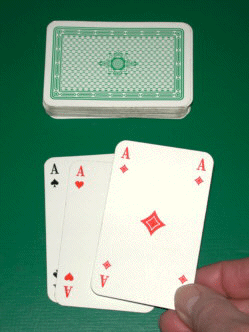Exercise 3.1Z: Drawing Cards
From LNTwww
From a deck of $32$ cards, including four aces, three cards are drawn in succession. For question (1), it is assumed that after a card has been drawn
- it is put back into the deck,
- the deck is reshuffled and
- then the next card is drawn.
In contrast, for the other sub-questions from (2) onwards, you should assume that the three cards are drawn all at once
("card draw without putting back").
- In the following, we use $A_i$ to denote the event that the card drawn at time $i$ is an ace.
Here we have to set $i = 1,\ 2,\ 3$ . - The complementary event $\overline{\it A_i}$ then states that at time $i$ no ace is drawn, but any other card.
Hints:
- The exercise belongs to the chapter Some preliminary remarks on 2D random variables.
- In particular, the subject matter of the chapter Statistical Dependence and Independence in the book "Stochastic Signal Theory" is repeated here.
- A summary of the theoretical basics with examples can be found in the (German language) learning video
Statistische Abhängigkeit und Unabhängigkeit ⇒ "Statistical Dependence and Independence".
Questions
Solution
(1) If the cards are put back after being drawn, the probability of an ace is the same at every time $(1/8)$:
- $$ p_{\rm 1} = \rm Pr (3 \hspace{0.1cm} aces) = \rm Pr (\it A_{\rm 1} \rm )\cdot \rm Pr (\it A_{\rm 2} \rm )\cdot \rm Pr (\it A_{\rm 3} \rm ) = \rm \big({1}/{8}\big)^3 \hspace{0.15cm}\underline{\approx 0.002}.$$
(2) Now, using the general multiplication theorem, we obtain:
- $$ p_{\rm 2} = \rm Pr (\it A_{\rm 1}\cap \it A_{\rm 2} \cap \it A_{\rm 3} \rm ) = \rm Pr (\it A_{\rm 1}\rm ) \cdot \rm Pr (\it A_{\rm 2} |\it A_{\rm 1}\rm ) \cdot \rm Pr (\it A_{\rm 3} |( \it A_{\rm 1}\cap \it A_{\rm 2} \rm )).$$
- The conditional probabilities can be calculated according to the classical definition.
- One thus obtains the result $k/m$ $($with $m$ cards there are still $k$ aces$)$:
- $$p_{\rm 2} =\rm \frac{4}{32}\cdot \frac{3}{31}\cdot\frac{2}{30}\hspace{0.15cm}\underline{ \approx 0.0008}.$$
- $p_2$ is smaller than $p_1$, because now the second and third aces are less likely than before.
(3) Analogous to sub-task (2), we obtain here:
- $$p_{\rm 3} = \rm Pr (\overline{\it A_{\rm 1}})\cdot \rm Pr (\overline{\it A_{\rm 2}} \hspace{0.05cm}|\hspace{0.05cm}\overline{\it A_{\rm 1}})\cdot \rm Pr (\overline{\it A_{\rm3}}\hspace{0.05cm}|\hspace{0.05cm}(\overline{\it A_{\rm 1}} \cap \overline{\it A_{\rm 2}} )) =\rm \frac{28}{32}\cdot\frac{27}{31}\cdot\frac{26}{30}\hspace{0.15cm}\underline{\approx 0.6605}.$$
(4) This probability can be expressed as the sum of three probabilities ⇒ $p_{\rm 4} = \rm Pr (\it D_{\rm 1} \cup \it D_{\rm 2} \cup \it D_{\rm 3}) $.
- The corresponding events $D_1$, $D_2$ and $D_3$ are disjoint:
- $${\rm Pr} (D_1) = {\rm Pr} (A_1 \cap \overline{ \it A_{\rm 2}} \cap \overline{\it A_{\rm 3}}) = \rm \frac{4}{32}\cdot \frac{28}{31}\cdot \frac{27}{30}=\rm 0.1016,$$
- $${\rm Pr} (D_2) = {\rm Pr} ( \overline{A_1} \cap A_2 \cap \overline{A_3}) = \rm \frac{28}{32}\cdot \frac{4}{31}\cdot\frac{27}{30}=\rm 0.1016,$$
- $${\rm Pr} (D_3) = {\rm Pr} ( \overline{A_1} \cap \overline{A_2} \cap A_3) = \rm \frac{28}{32}\cdot \frac{27}{31}\cdot \frac{4}{30}=\rm 0.1016.$$
- These probabilities are all the same - why should it be any different?
- If you draw exactly one ace from three cards, it is just as likely whether you draw this as the first, second or third card.
- This gives us for the sum:
- $$p_{\rm 4}= {\rm Pr} (D_1 \cup D_2 \cup D_3) \rm \hspace{0.15cm}\underline{= 0.3084}.$$
(5) If one defines the events $E_i =$ »Exactly $i$ aces are drawn« with the indices $i = 0,\ 1,\ 2,\ 3$,
- then $E_0$, $E_1$, $E_2$ and $E_3$ describe a "complete system".
- Therefore:
- $$p_{\rm 5} = {\rm Pr} (E_2) = 1 - p_{\rm 2} - p_{\rm 3} - p_{\rm 4} \hspace{0.15cm}\underline{= \rm 0.0339}.$$
